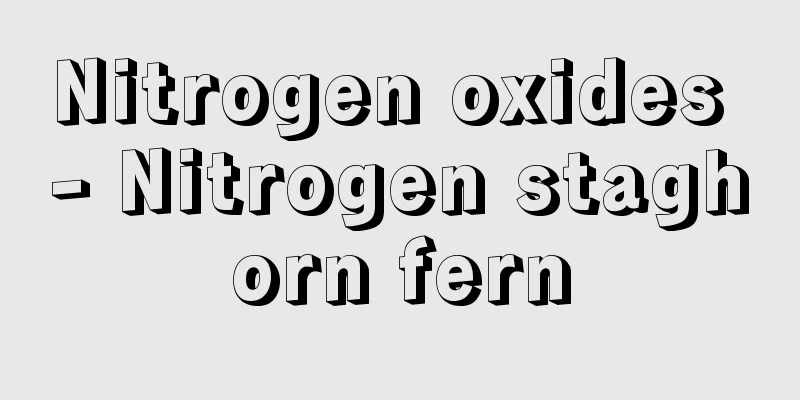Nitrogen oxides - Nitrogen staghorn fern

|
[ I ] A general term for compounds represented by NOx . Seven types are known: dinitrogen monoxide ( N2O ), nitric oxide (NO), dinitrogen trioxide ( N2O3 ) , nitrogen dioxide ( NO2 ) , dinitrogen tetroxide ( N2O4 ) , dinitrogen pentoxide (N2O5), and nitrogen trioxide (NO3 ) . [ II ] As a pollution term, a general term for NO and NO2 . Abbreviated as NOx . It is mainly produced by the combustion of fuel. Most of the initial product is NO, which is oxidized in the air to become NO2 . Most is produced by the combination of N2 and O2 in the air due to the high temperature during combustion (thermal NOx ), but some is caused by nitrogen compounds in the fuel (fuel NOx ). It can also be emitted from nitric acid and explosives manufacturing plants. Oxidation reaction of NO to NO2 in a pure NO- O2 mixture Source: Morikita Publishing "Chemical Dictionary (2nd Edition)" Information about the Chemical Dictionary 2nd Edition |
|
【Ⅰ】NOxで表される化合物の総称.一酸化二窒素N2O,一酸化窒素NO,三酸化二窒素N2O3,二酸化窒素NO2,四酸化二窒素N2O4,五酸化二窒素N2O5,三酸化窒素NO3の7種類が知られている.【Ⅱ】公害用語としては,NOとNO2の総称.略称NOx.おもに燃料の燃焼によって生じる.このとき最初にできるものは大部分がNOであり,NOは空気中で酸化されてNO2となる.大部分は燃焼のときの高温により,空気中の N2 と O2 が化合してできるが(熱的NOx),一部は燃料中の窒素化合物に起因する(燃料NOx).そのほか,硝酸製造工場,火薬製造工場から排出されることもある.純粋なNO-O2混合物でのNOのNO2への酸化反応 出典 森北出版「化学辞典(第2版)」化学辞典 第2版について 情報 |
Recommend
Lyncurium
…The ancient Chinese believed that when a tiger d...
Gosudarstvennyi ordena Lenina akademicheskii Bol'shoi teatr SSSR
…Premiere: Mozart's Don Giovanni, September 2...
Dermatemys mawi (English spelling) Dermatemysmawi
...There are about 182 species distributed throug...
arête (English spelling) arete
…Its shape resembles an amphitheater (Latin circu...
Shiratamako - Shiratamako
Flour made from polished glutinous rice. In the p...
Ephydatia muelleri (English spelling)
...These clusters of blasts are also called "...
White, Shaun
Born: September 3, 1986. San Diego, California. An...
Gaspé Peninsula - Gaspé Peninsula (English spelling)
A peninsula on the right bank of the St. Lawrence ...
Pyrogallol - Pyrogallol (English spelling)
A polyhydric phenol. It stands for 1,2,3-trihydro...
Ganzan Daishi
Another name for Ryogen, a Tendai Buddhist monk fr...
Vaugelas, Claude Favre
Born: January 6, 1585. Meksimyu Died February 1650...
Imiaki
〘noun〙① The end of the mourning period. Imiake. Ki...
Wading birds
Originally, the term was used in herbal medicine ...
Kasaoka [city] - Kasaoka
A city in the southwestern tip of Okayama Prefectu...
The Galaxy
The galaxy to which the sun belongs. It is one of...









